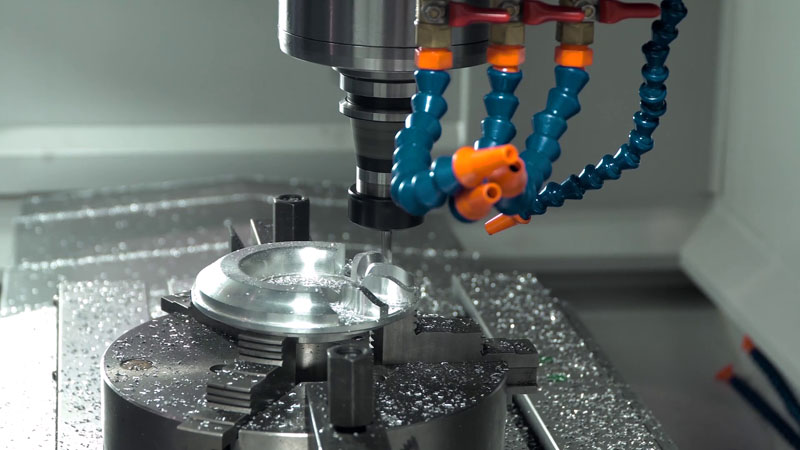In today’s fast-paced manufacturing environment, efficiency and precision are critical to the success of product development. CNC milling, or Computer Numerical Control milling, has become a pivotal technology in improving both the speed and accuracy of the product development process. By leveraging automated, high-precision cutting, CNC milling streamlines the production cycle, reduces errors, and enhances overall product quality. This post explores how CNC milling optimizes the efficiency of product development and helps manufacturers meet modern challenges.
Precision and Consistency
CNC milling offers unmatched precision and repeatability, key factors that significantly impact the efficiency of product development. Traditional milling techniques rely heavily on the skill of the operator, which can lead to inconsistencies, errors, and time-consuming adjustments. In contrast, CNC milling systems operate using computer programs that control the movement of the cutting tool with high accuracy. This ensures that each part is manufactured to exact specifications with minimal variation.
The consistency provided by CNC milling not only enhances the quality of the product but also reduces the need for rework, saving valuable time and resources in the development process. With this technology, developers can create prototypes and production parts with confidence, knowing that each component will meet the required tolerances.
Faster Prototyping and Iteration
One of the greatest advantages of CNC milling in product development is the ability to rapidly prototype and iterate designs. Traditional machining methods often require a significant amount of time to set up and adjust, whereas CNC milling allows for quick changes to designs without the need for extensive tool or machine modifications. When product designs evolve or require adjustments, CNC milling systems can be easily reprogrammed to accommodate new specifications.
This speed in prototyping and iteration accelerates the design process, allowing product developers to test new ideas, refine existing designs, and bring products to market faster. The ability to rapidly prototype and adjust designs also helps reduce development costs by minimizing the need for costly and time-consuming tooling changes.
Complex Geometries and Customization
Modern products often require intricate geometries that are difficult, if not impossible, to achieve using traditional machining methods. CNC milling’s ability to handle complex shapes with high precision makes it an invaluable tool for creating innovative designs. From multi-axis milling capabilities to the use of specialized cutting tools, CNC milling can produce intricate details with ease.
This flexibility allows manufacturers to customize products based on customer requirements or specific industry needs. Whether creating parts for aerospace, automotive, medical devices, or electronics, CNC milling allows for a high degree of customization without sacrificing efficiency. As a result, manufacturers can meet the specific needs of their clients while maintaining efficient production schedules.

Reduced Lead Times
CNC milling helps reduce lead times by automating much of the machining process, allowing for faster production cycles. The automated nature of CNC machines means that after initial setup, the machine can run continuously without the need for constant operator supervision, ensuring that parts are produced quickly and consistently. Additionally, CNC milling systems are capable of operating in multiple shifts, further shortening lead times.
This reduction in lead time allows product developers to get products to market faster and respond quickly to customer demands or changes in the design. The ability to maintain a faster production pace without compromising quality is crucial in industries where time-to-market is a competitive advantage.
Minimized Material Waste
CNC milling optimizes material usage by employing precise cutting methods that generate less waste compared to traditional machining processes. The ability to accurately control tool paths ensures that material is only removed where necessary, reducing scrap rates and maximizing the efficiency of raw materials. Additionally, CNC milling can use advanced techniques like adaptive toolpaths, which adjust cutting strategies in real-time to minimize material consumption.
By reducing material waste, manufacturers not only lower their material costs but also contribute to more sustainable production practices. In industries where cost control and sustainability are priorities, CNC milling offers significant benefits in both areas.
Cost-Effectiveness and Reduced Labor Costs
While the initial setup costs for CNC milling equipment can be significant, the long-term benefits far outweigh the initial investment. CNC milling reduces the reliance on manual labor, cutting down on operator errors and minimizing the need for highly skilled workers for routine tasks. The automation of the milling process also allows for fewer interruptions during production, making it easier to maintain consistent output.
Moreover, the precision and efficiency of CNC milling reduce the need for costly rework or scrapped parts, leading to overall cost savings. This, in turn, allows manufacturers to offer more competitive pricing while maintaining high-quality standards.
Integration with CAD/CAM Systems
CNC milling is seamlessly integrated with CAD (Computer-Aided Design) and CAM (Computer-Aided Manufacturing) software, enabling a fully digital workflow from design to production. CAD software allows product developers to design parts with precise specifications, while CAM software translates these designs into machine instructions that CNC mills can execute. This integration reduces the risk of errors, ensures that the final product matches the design, and simplifies the transition from design to production.
With CAD/CAM integration, product developers can simulate machining operations before production begins, allowing them to identify potential issues and optimize the machining process for efficiency. This digital workflow also facilitates better communication between design, engineering, and manufacturing teams, further improving the efficiency of product development.
Scalability for Production Runs
CNC milling excels in both low- and high-volume production runs. In low-volume production, such as for prototypes or small batches, CNC milling offers flexibility and fast turnaround times, allowing manufacturers to quickly adjust to design changes or customer specifications. For high-volume production, CNC milling machines can be programmed for repeatable, automated operation, ensuring that products are produced consistently with minimal intervention.
This scalability makes CNC milling an ideal solution for manufacturers who need to handle varying production demands without sacrificing quality or efficiency.
Conclusion
CNC milling plays a crucial role in improving efficiency in product development, offering numerous advantages over traditional machining methods. From precision and reduced lead times to material efficiency and customization capabilities, CNC milling allows manufacturers to streamline the product development process, reduce costs, and improve overall product quality.
By integrating CNC milling into the design and manufacturing process, product developers can create more complex, precise, and high-quality products in less time. The ability to rapidly prototype, iterate designs, and scale production efficiently makes CNC milling a cornerstone of modern manufacturing, driving innovation across industries and accelerating the journey from concept to market.



